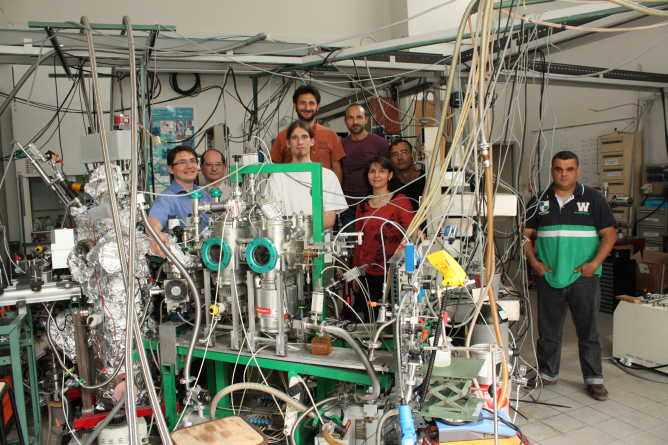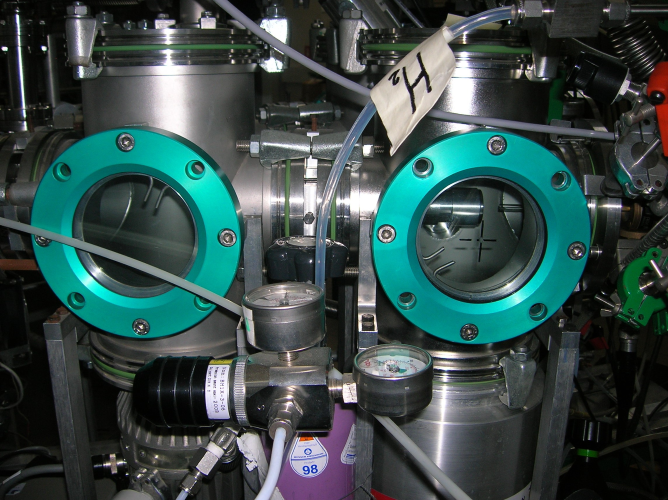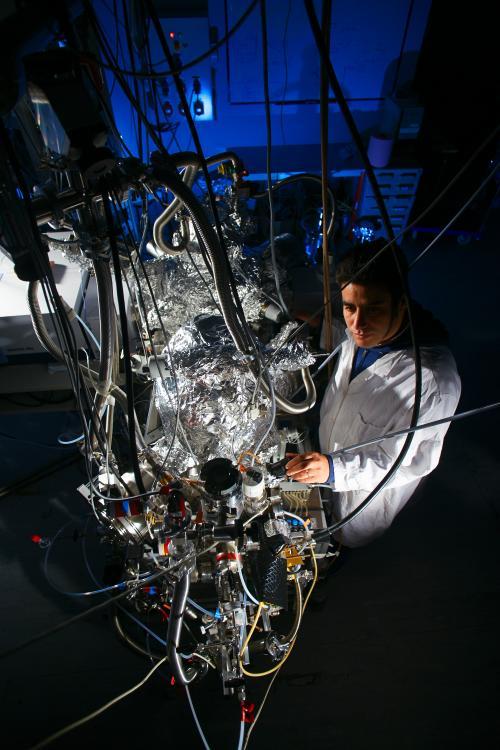You are here :
- Unité de recherche
- LERMA
- Home
- Our devices
Research
Published on November 8, 2021– Updated on November 8, 2021
Our devices
The principe is rather simple, atoms and radicals have to be deposited on a cold substrate mimicking the dust grains. Thus they have to be detected. Classically it is done with Infra-red spectrometry (in-situ measurements for IR active molecules), or Thermally Programmed Desorption (destructive but sensitive technique), sometimes both of them.
Our team owns two state-of-the-art experimental set-ups (FORMOLISM and VENUS), which have been very productive the last years. Radicals are produced in plasma sources (up to 4 at the same time), and are aimed at the substrate UHV chamber, through a triple stage differential pumping. New molecules produced at low-temperature on interstellar analogues are detected by quadrupole mass spectroscopy, Fourier transform infrared spectroscopy or resonance enhanced multiphoton ionization (http://lerma.obspm.fr/spip.php?article48). FORMOLISM has been adapted to the study of PAH (movable coronene oven and possibility to go to “high” temperatures (750K)). VENUS is more devoted to the study of ice and complex molecules. The overlap is large, and depending on the study, each apparatus propose both advantages and defaults.




Our team owns two state-of-the-art experimental set-ups (FORMOLISM and VENUS), which have been very productive the last years. Radicals are produced in plasma sources (up to 4 at the same time), and are aimed at the substrate UHV chamber, through a triple stage differential pumping. New molecules produced at low-temperature on interstellar analogues are detected by quadrupole mass spectroscopy, Fourier transform infrared spectroscopy or resonance enhanced multiphoton ionization (http://lerma.obspm.fr/spip.php?article48). FORMOLISM has been adapted to the study of PAH (movable coronene oven and possibility to go to “high” temperatures (750K)). VENUS is more devoted to the study of ice and complex molecules. The overlap is large, and depending on the study, each apparatus propose both advantages and defaults.
FORMOLISM
FORMOLISM is developed since 2001.
It is evolving in FORMOLISM2 in June 2020.
Major characteristics:
- UHV.
- Surfaces: 3 movable samples (e.g. graphite, gold, silicate). Surface temperature control: 10-800K.
- 2 atomic or molecular beams aimed at the sample (e.g. H, N, O, CO,…).
- In-situ controlled water ice growing system (amorphous, porous, crystalline…) or carbonaceous dust deposition (e.g. PAH coronene).
Detection tools:
- Mass spectrometry (its use is fourfold) : Beam compositions, During Exposure Detection, Thermally Programmed Desorption, Internal energy of atoms or molecules.
- Reflection Absorption Infra Red Spectroscopy.
- Laser system (REMPI 2+1) coupled with a time of flight detection.
In development:
- Angular distribution measurements.
- New sources of atoms and radicals.



VENUS
Developped since 2011
- Up to 5 atomic or molecular beams. Only 2 presently running.
- Surfaces : Rotatable sample holder with 3 surfaces.
- Temperature Range : 10-300K
- Mass spectrometry (its use is fourfold) : Beam compositions, During Exposure Detection, Thermally Programmed Desorption, Internal energy of atoms or molecules.
- Reflection Absorption Infra Red Spectroscopy.



